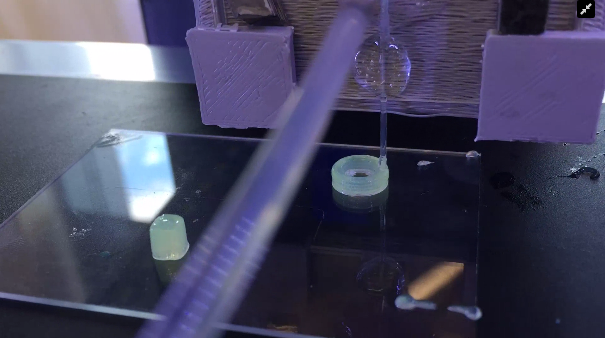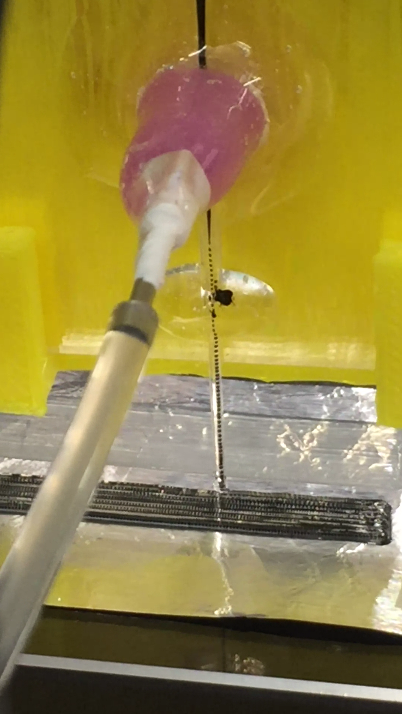As the name suggests, microfluidics is centered around the behavior, manipulation, and control of fluids that have been constrained to a very small scale. Obviously, accurate handling is of the utmost importance when you’re dealing with fluids at sub-millimeter levels, and a team of engineers with the University of California, Davis (UC Davis) has published a research paper in the Proceedings of the National Academy of Sciences (PNAS) journal about their work 3D printing flexible materials using a new droplet-based microfluidic system.
“Here, we present an approach to modulate extruded inks at the point of print, using droplet inclusions,” the abstract states. “Our approach represents a continuing trend of adapting microfluidic technology and principles for developing the next generation of additive manufacturing technology.”
Extrusion-based printing is cost-effective, and efficient, but it’s difficult to fabricate components out of multiple materials with the optimal amount of softness. Jiandi Wan, an assistant professor of chemical engineering at UC Davis, realized that the typical 3D printer nozzle is not dissimilar to the glass capillary microfluidic devices studied by students in his lab, which feature several nozzles placed inside of each other.
Wan said, “Most extrusion-based 3D printers use very simple nozzles and since we had already developed these glass microfluidics, we thought, ‘why not apply it to 3D printing?'”
Together with Hing Jii Mea, a UC Davis graduate student, and Luis Delgadillo from the University of Rochester, Wan created a device that can enclose droplets of a water-based solution, composed of polyethylene glycol diacrylate (PEGDA), in the common silicone-based organic polymer polydimethylsiloxane (PDMS). This device uses a multiphase drip system to create small PEGDA droplets. PDMS flows around the dripper while this is happening, and the PEGDA droplets are introduced evenly into the silicone-based polymer; this way, both of the materials will flow together onto whatever structure is being 3D printed.
This system actually makes it possible to adjust the flexibility of a 3D printed structure, which could be very beneficial in applications such as wearable technology, tissue engineering, soft robotics, and bioprinting. The tiny PEGDA droplets are surrounded by the PDMS material, and once the PEGDA is diffused out, the PDMS is chemically softened — resulting in a more flexible structure.
Wan explained, “You can also encapsulate other chemicals in the droplets to make the overall matrix much softer or harder.”
In their study, the researchers found that the PEGDA droplets significantly altered the “local PDMS chemistry,” reporting 3D printed constructs with a reduced elastic modulus of 85%. They also determined that the structural flexibility can be tuned by changing the flow rate and size of the droplets, and that their new droplet-based system can also make flexible components that are porous.
They can actually vary “the spatial distribution of droplets” in situ to manipulate the mechanical characteristics, “including aqueous and liquid metal droplets.”
“Furthermore, we imparted magnetic functionality in PDMS by dispersing ferrofluid droplets and rationally designed and printed a rudimentary magnetically responsive soft robotic actuator as a functional demonstration of our droplet-based strategy,” they wrote in the paper.
Because the system makes it so easy to manipulate the flexibility of the material, researchers can enjoy an increased number of options when it comes to 3D printed microfluidic devices.
Wan stated, “I think this will open a new area of research, since applying the established microfluidics technology to 3D printing represents a new direction to go.”

This cube was printed with a new technique that allows embedding of droplets of different materials within the structure. These droplets can be used to make 3D printed structures flexible or to give them other properties. (Image courtesy of Jiandi Wan, UC Davis)
The UC Davis team believes it’s the very first to use this type of “droplet-based multiphase emulsion,” and is actively investigating what other material combinations they can use in their new system to manipulate the chemical and mechanical properties of 3D printed products.
(Images: Screenshots of UC Davis team’s research videos)
Subscribe to Our Email Newsletter
Stay up-to-date on all the latest news from the 3D printing industry and receive information and offers from third party vendors.
You May Also Like
Precision at the Microscale: UK Researchers Advance Medical Devices with BMF’s 3D Printing Tech
University of Nottingham researchers are using Boston Micro Fabrication‘s (BMF) 3D printing technology to develop medical devices that improve compatibility with human tissue. Funded by a UK grant, this project...
GaeaStar and Verve Coffee Roasters Start Pilot Production of Sustainable 3D Printed Coffee Cups
Following a 2022 debut in Germany, GaeaStar, a startup based in San Francisco and Berlin, has begun US pilot production of its sustainable, disposable clay cups and bowls made with...
Meltio and Accufacture Unveil Robotic Metal 3D Printer Made in the US
Meltio has partnered with Michigan-based robotics firm Accufacture to introduce Alchemist 1, a robotic cell designed for wire-laser metal 3D printing made in the US. This new system represents a...
WASP Highlights Advances in Healthcare 3D Printing at Italy’s Exposanità 2024
WASP takes center stage at Italy’s leading healthcare expo, Exposanità 2024, demonstrating the transformative impact of its advanced 3D printing technologies on the medical sector. Known for its line of...


































